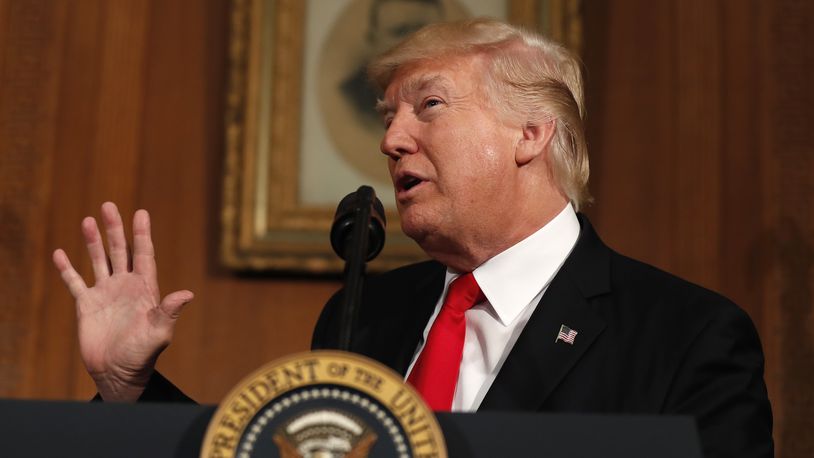But at least one experts thinks the contention that high corporate tax rates have held back economic growth is misleading, and says there’s no guarantee that cutting the rate will ultimately accelerate growth.
“I think the whole premise upon which this (tax plan) is based is faulty,” said Zach Schiller, research director for the left-leaning Policy Matters Ohio in Cleveland. “The idea that U.S. companies pay higher taxes is flawed. They don’t. They may be taxed at a higher rate in the tax code, but that’s not what most companies pay.”
RELATED: Tax incentives don't always lead to job creation with Ohio companies
In fact, many large companies historically have paid little or no taxes, based on a report last year from the Government Accountability Office (GAO), which found about 20 percent of large U.S. corporations that reported a profit in 2012 paid nothing in U.S. corporate income taxes. In addition, the GAO estimated that 21-24 percent of large profitable corporations owed no income tax in the previous three years, utilizing a variety of tax deductions and write-offs not available to ordinary taxpayers.
The Trump plan would also cut taxes for small businesses to help them compete more effectively in the marketplace by lowering the individual tax rates for so-called pass-through entities, such as partnerships, limited liability companies or S corporations.
RELATED: Trump visit puts business on center stage
Pass through entities aren’t taxed as businesses, but their owners must include a share of the business profits in their taxable income. Ohio already allows a $250,000 deduction on business profits for pass-through entities.
The Trump plan would enhance the tax savings for small businesses, which is a “step in the right direction,” according to John Stafford, president of the family owned Stafford Jewelers, headquartered in Dayton.
“I think we can all agree, no matter what side of the political spectrum you’re on, that small business is the backbone of the United States,” Stafford said. “This (tax plan) will help small businesses thrive by no overtaxing them.”
For the vast majority of small, family-owned firms selling goods or services, lower tax rates would also help them level the playing field with online competitors who often are not required to collect sales tax in states where they do not have a physical presence.
“All these smaller businesses are going out of business because they’re losing sales (to Web-based firms) that don’t have to charge a tax,” Stafford said. “Without those small business thriving, especially here in the Miami Valley, the economy is crushed.”
RELATED: Tax challenge could impact online sales in Ohio
Overall, President Trump’s tax cuts will have some positive impact that will boost the economy, providing incentives for investment, job creation and ultimately growing the size of the economy, according to Orphe Divounguy, an economist at The Buckeye Institute, a conservative think-tank in Columbus. But it’s doubtful that the Trump tax cuts alone can boost growth enough for them to pay for themselves, as the Trump administration has asserted, according to Divounguy.
“This sums up to unfunded tax cuts that will eventually have to be repaid,” he said. “The policy is mostly deferring the burden of taxation unless the government share of the economy shrinks to reflect the decrease in revenue.”
For individuals, Trump’s tax plan would nearly double the standard deduction that Americans can use to reduce their taxable income, resulting in big tax savings for most people, although it would eliminate many other popular deductions that Americans claim.
RELATED: Property taxes high in Ohio and Dayton
Some analysts have predicted Trump’s tax plan will cut so much in government revenue that it would ultimately add billions, if not trillions, of dollars to the federal budget deficit without tax increases in some other areas.
According to a recent analysis from the Tax Foundation, a conservative Washington, D.C.-based think tank, the economy would have to grow five times larger to make up for an estimated $2 trillion losses in tax revenue over the next decade if the corporate rate is reduced to 15 percent.
Top White House officials outlined President Donald Trump’s tax plan Wednesday, a proposal they said would be the “biggest tax cut” in U.S. history.
Here are some of the highlights of the plan:
• Trump’s plan will cut the number of income tax brackets from seven to three, with a top rate of 35 percent and lower rates of 25 percent and 10 percent. It is not clear what income ranges will fall under those brackets. It would also double the standard deduction.
• The proposal will chop the corporate tax rate to 15 percent from 35 percent.
• It would eliminate tax deductions, with only a few exceptions, including the mortgage interest and charitable contribution deductions.
• The plan would get rid of the estate tax, otherwise known as the “death tax.” The will help privately held businesses and American farmers. Analysis of the estate tax reveals that it affects only a very small portion of Americans.
• Trump’s plan would also repeal the alternative minimum tax and 3.8 percent Obamacare taxes.
About the Author
